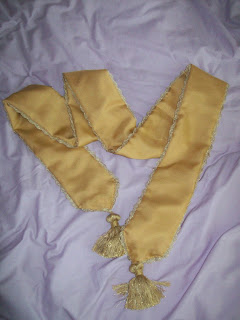The pattern in question was this Cinema Doll echarpe. This was probably the item that started off the sash trend that followed. After some unsuccessful attempts, I gave up about this sash and then forgot about it. But then I decided to sit down and actually properly think about the instructions and see if I really needed to know Japanese to make the sash. So, did I need to know Japanese?
The answer is no, I did not. This gold sash was made using the GLB pattern but I altered it slightly to make it a bit simpler. The main thing I altered was I made the sash as one continuous length, whereas the pattern is split in to halves. So I just had 2 long lengths to sew together and put the desired trims in the seams. I did put a chiffon overlay over a cotton base, just because I liked the look of the chiffon better. It was the chiffon that proved to be the biggest challenge for me, as I hand-stitched the entire thing and chiffon is a real pain to work with.
So my biggest piece of advice to anybody thinking of making something from a Japanese pattern would be this- use some common sense. I was able to work out how to make the sash because I sat down and figured out the rough order of how to make the sash. If need be, make a version using cheap materials so you can see how it will come together. I actually made a navy blue sash before this one and I admit I did make a few mistakes with that one. But it meant that I had a much better idea about how to make this gold one, and I feel the gold one turned out a lot better. A lot of the reason why I decided to make a sash using one continuous length is because I couldn't quite figure out how to make the sash if you used 4 pieces. So I came up with my own way of making the pattern simpler so I would know what I was doing.
It does help if you can figure out the materials, even if you don't end up translating everything. It helps to look at the quantities at the end. If you have a quantity like (random number) x (random number) then you know the material has to be a square, so it is going to be something like fabric or interfacing. If it is one number with cm after it, then you know it is going to be one length, like a line of lace for example. If it has something like x(number) then you are probably going to need some sort of embellishment, like a tassel. Look at the item you are trying to make to see if you can spot all the materials mentioned in the list. Once you have a rough idea of which materials are which, you can try and see if you can spot these words in the instructions, so you know when you need to use which bit.
It is also worth seeing if you can find a version of what you want to make in your own language. I did look up a few sash tutorials in English, but to be honest, none of them looked as fancy as the GLB one. However, it did at least give me a rough idea of what I was doing.
And if all else fails, there is always the option of trying to translate the text. I found this link helpful- http://www.japanesesewingbooks.com/japanese-sewing-terminology-a-list-of-translated-terms/ There was also an English GLB which had some useful sewing terms (I think it was the flower issue).
I also searched hiragana chart online so I could translate some of the bits which were not covered. It sounds tricky, but if you take your time you may be surprised how much you can achieve. You may find that some words look very similar to English words. For example "ke-mi-ku-ru" when said out loud sounds a bit like "chemical", so I worked out I was going to need chemical lace.
So I suppose I did cheat a little, because my sash design is simpler. But I was really pleased that I had taken the time to work out how to make the sash. I am confident now that I could make a more intricate sash in the future. I would really recommend making a sample of your item with cheap materials first though. It is not worth wasting money on expensive materials if you don't know what you are doing. I would definitely give interpreting patterns another go in the future. Alternatively, you could just ask somebody very nicely if they will translate the pattern for you!



No comments:
Post a Comment